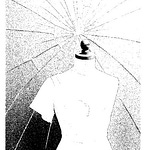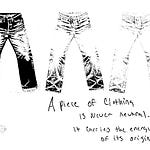Margiela Couture: The Return of the Mundane Sublime
There was something quietly triumphant about Glenn Martens’ latest couture outing for Margiela. It felt like a return, a return not just to form, but to faith. A sigh of relief for those of us who’ve long believed that the brand’s soul had gone dormant. In this collection, Martens proved that he understands where he is. He understands the belief system.
More than that, he understands that Margiela was never just a look, it was a philosophy. A practice of seeing. A reverence for the overlooked. And what Martens brings back is that central aesthetic doctrine: the sublime hidden in the mundane.
Yes, Galliano captured the Margiela spirit, its deconstruction, its theatrical wit, but his world became increasingly baroque. And while many admired his dramatics, they edged further away from the quietly radical sensibility that made Margiela cult-like to begin with. That aesthetic, the one anchored in the prosaic, the worn, the discarded, was slowly eclipsed by spectacle.
Margiela, at its core, was about extracting desire from the undignified. The beauty of a patina, the elegance of aging fabric, the color of something used, lived-in, forgotten. It wasn’t just nostalgia, it was a kind of alchemical elevation of the everyday. Turning the banal into the aspirational. That was Martin’s magic.
And it’s precisely this that Martens revives. His Margiela operates in that liminal space, between realism and fantasy, between the street and the salon. His silhouettes are more wearable, yet still poetic. His colors feel unearthed rather than chosen, tones born from use, from decay, from memory. He doesn’t chase perfection, he reveals the perfection that’s already there, hidden in the folds of the ordinary.
What Galliano sometimes lacked was this grounding. His Margiela, though technically brilliant, often floated too far from the earth, too drenched in theater, not enough in life. Margiela was always more radical in restraint than in costume. It found its power not in fantasy, but in familiarity.
And perhaps it matters, too, that Glenn is Belgian. There’s something in that Belgian restraint, that intellectual pragmatism, that quietly critical eye, which fits the Margiela legacy far more naturally than Galliano’s operatic maximalism.
If nothing else, Martens reminds us that beauty doesn’t have to be loud to be revolutionary. Sometimes, the most radical thing you can do is look closely at what’s already there, and show it back to us, reassembled, with reverence.
Margiela’s True Material: Time Itself
One dimension that deserves deeper attention, one that Glenn Martens seems to understand on an almost instinctive level, is the concept of the passage of time. Not just as an aesthetic detail, but as a foundational philosophy. In many ways, the passage of time is the most important code of the Margiela house. If there were a single idea that could encapsulate the brand’s ethos, it would be this.
Time, for Margiela, is not simply a matter of patina or wear. It’s not just faded fabric or cracked leather. It’s memory, culture, and transformation, embedded into the very surface of things. It reflects the life that has passed through the garment. The choices made. The values held. The traces of human experience.
What makes this idea powerful is that it shifts the focus from aesthetics to meaning. The beauty isn’t just in the appearance of aging, it’s in what the aging process represents. It tells the story of people and eras, of shifting ideals and forgotten rituals. The garment becomes a vessel of memory, not just an object of design.
A great designer doesn’t stop at referencing time, they interpret it. They understand that aging isn’t just visual, it’s emotional. The real task is to extract not just the residue of time, but the meaning within it. Glenn Martens appears to be doing exactly that. His work doesn’t just show the effects of time, it reflects the life that created them.
To design with time as a material is to design with humanity itself. That’s what Margiela has always done at its best, transform the remains of what once was into a new kind of beauty. One that doesn’t forget. One that remembers.
In Martens’ Fall/Winter 2025 Artisanal show, staged in a former undertaker’s hall with peeling walls and coffins in the memory of the space, time was the stage. The venue itself became a metaphor: decay, memory, and legacy in balance.
Garments were built from deadstock fabrics, thrifted garments, even costume jewelry and old metal boxes, revived and reassembled into striking couture pieces. Each texture carried sediment of past lives: worn metal, simmered textiles, gothic draping. It felt as though time had been sculpted, not just shown.
Take the crystal-encrusted masks and trompe-l’œil surfaces that looked grown from the walls themselves, medieval Flemish references twisted into grotesque beauty. These weren’t gestures toward history. They were archaeological finds of emotion, worn on the face.
Martens doesn’t just show wear, he reveals what wore it down. A cathedral-like steel mask didn’t just reference structural grandeur, it carried the weight of centuries, of sanctity tarnished by human hands. That interplay of ruin and ritual kept the work from becoming nostalgia, it anchored it in lived complexity.
Here, time is not a backdrop. It is the material. Through it, Martens weaves memory (masks and faded grandeur), culture (referencing his Belgian roots and Flemish architecture), and identity (upcycled garments assuming new roles). He transforms decay into narrative, surfaces into story, residue into resurrection.
That is the genius of this collection. It isn’t just clothes that look aged, it’s clothes that remember. Gloriously, unapologetically. And that’s exactly what Margiela has always been: time made visible, life made couture.












